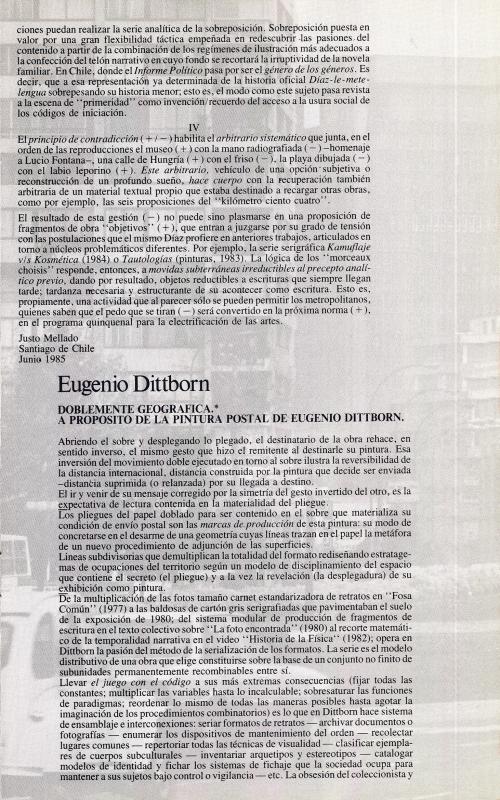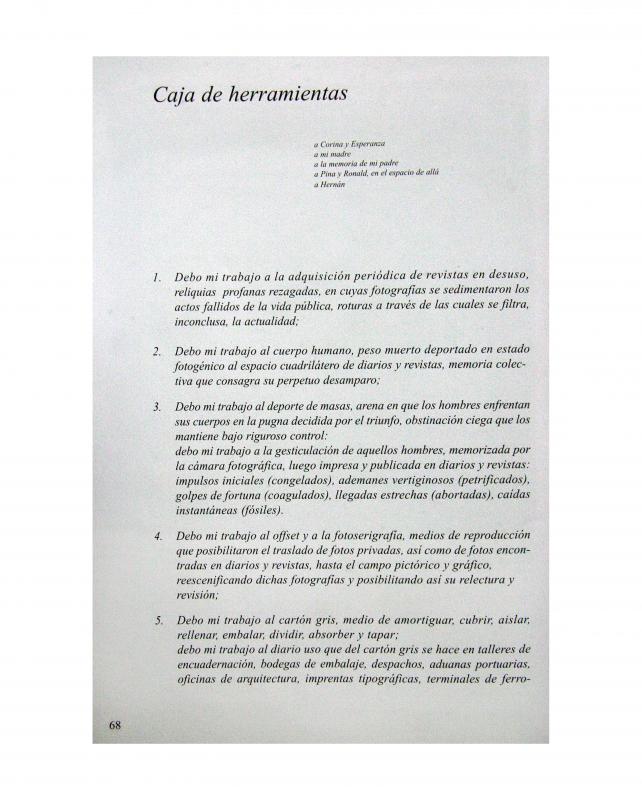In his essay “Correcaminos” [Roadrunner] Eugenio Dittborn (b. 1943) describes the airmail paintings project he began in 1984. This text appears in Pinturas postales de Eugenio Dittborn [Mail Paintings by Eugenio Dittborn] (1985), the catalogue edited by Francisco Zegers that also included essays by the theorist and cultural critic Nelly Richard (b. 1948), the poets Gonzalo Millán (1947–2006) and Gonzalo Muñoz (b. 1956), and the philosopher Pablo Oyarzún (b. 1950). [For other texts in this catalogue, see the following in the ICAA Digital Archive: “Por miradas” (doc. no. 735231) by Millán; “Protocollage de lectura” (doc. no. 735197) by Oyarzún; and “Una política” (doc. no. 735205) by Muñoz.] This catalogue appeared after the exhibitions 12 pinturas aeropostales [12 Airmail Paintings] (Galería Sur, September) and 6 pinturas aeropostales [6 Airmail Paintings] (Galería Bucci, October), both of which were held in 1985. The journeys taken by the airmail paintings were: Santiago / Cali (Colombia) / Santiago (21 pinturas aeropostales, June 1984); Santiago / Sydney (Australia) / Santiago (10 pinturas aeropostales, 1984–85); Santiago / Melbourne (Australia) / Santiago (7 pinturas aeropostales, May 1985); Santiago / Buenos Aires (Argentina) / Santiago (7 pinturas aeropostales, June 1985). [On the subject of the latter two journeys see the essay by Nelly Richard: “Eugenio Dittborn: Doblemente geográfica. A propósito de la pintura postal” (doc. no. 734740).]
Pinturas aeropostales [Airmail Paintings] is the title of the project Dittborn began working on in 1984. He painted on large sheets of fabric that were then folded and tucked into envelopes that were also part of the work. When the envelope was ready the painting was mailed to the exhibition site, where it was unfolded and hung on the wall. The envelopes were exhibited along with the paintings to show evidence of the mailing process: the stamps, recipient’s address, and return address. The creases that form a grid of rectangles on the fabric and the lack of a frame are two characteristics that set this genre apart from traditional painting. Dittborn’s airmail paintings usually consisted of photo screenprinted images from newspapers, magazines, comics, or drawing manuals, and children’s drawings. They included faces and a wide range of iconographies. Fabrics sometimes overlapped and were patched and had seams. Dittborn continues to explore the same process to this day. [He wrote about the processes that provided him with the images he used in his airmail paintings in his essay “Caja de herramientas” [Toolbox] (doc. no. 732125).]




